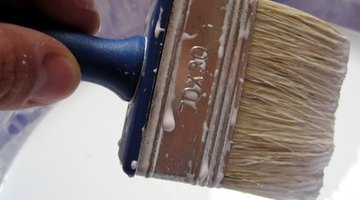How to Paint Vinyl or Linoleum
If you don’t like the pattern or color of your vinyl or linoleum floor, there is a way to replace it. You can paint over the vinyl or linoleum after careful preparation of the floor's surface. You can then transform your floor without having to rip up the old vinyl or linoleum or buying new.

Things You Will Need
- Blue painters tape
- Rubber gloves
- Safety glasses
- Bucket
- Trisodium phosphate (TSP)
- Hot water
- Orbital sander
- 220-grit sandpaper
- Broom
- Liquid deglosser
- Rag
- Primer
- Paintbrush or roller
- Paint
- Oil-based clear coat finis
Painting these two surfaces won’t cost you a fortune or cause a big mess, but it will give your vinyl or linoleum a new look.
-
Protect the baseboards by putting some blue painters tape over the bottom. If you want to paint the baseboards the same color as your floor, then place the blue painter’s tape at the top of the baseboard on the wall to protect your wall.
-
Clean the floor thoroughly. Put on a pair of rubber gloves and safety glasses. Mix ½ cup trisodium phosphate (TSP) with 2 gallons hot water. This removes all the grease and dirt. Wash the floor with a mop.
-
Rinse the TSP off the floor. Fill a clean bucket with clean water and use a clean mop. Change the water in the bucket when it becomes dirty. Allow the floor to dry thoroughly.
-
Sand the floor with an orbital sander equipped with 220-grit sandpaper. This dulls the shine and helps the paint to adhere better. You can also use a sanding sponge if you don't have an orbital sander.
-
Sweep the debris off the floor and then apply a liquid deglosser to the vinyl surface with a rag. The liquid deglosser removes the dust caused from the sanding, and it removes any leftover gloss. The surface has to be free from dust or it will show up on the painted floor.
-
Prime the floor with a primer. Choose a primer that is made for vinyl or linoleum surfaces. Use a paintbrush to apply the primer around the outside perimeter of the room. You can continue to use a paintbrush to paint the rest of the floor, or you can switch to a roller. Allow the primer to dry. You will only need one coat of primer.
-
Paint the floor with two coats of paint. Paint with a paintbrush around the perimeter of the room. You can continue to use a paintbrush to finish the floor or you can use a roller. Allow the first coat of paint to dry overnight. The second coat needs to dry for at least 24 hours or according to manufacturer's directions.
-
Apply two thin coats of an oil-based clear coat finish. Allow the first coat to dry according to manufacturer’s directions before applying the second coat. Allow the second coat to dry for 24 hours before walking on it. Touch the floor to see if the surface is dry or sticky. If it still feels sticky, leave it to dry until it no longer feels dry. The drying time depends on how much humidity is in the air.
Tip
Open the doors and windows when using trisodium phosphate (TSP), because it can cause irritation. Have adequate ventilation when applying the oil-based clear coat finish. Do not walk on the floor with shoes or bare feet for 2 weeks. This gives the surface time to cure.
References
- “Painting Secrets;” Brian Santos; 2004
- Paint Splashes: Restore Vinyl Flooring With Paint
- Propdaddy Creations: Painting a Vinyl Floor
Tips
- Open the doors and windows when using trisodium phosphate (TSP), because it can cause irritation.
- Have adequate ventilation when applying the oil-based clear coat finish.
- Do not walk on the floor with shoes or bare feet for 2 weeks. This gives the surface time to cure.
Writer Bio
Gail Delaney is a writer in South Dakota and has articles published online at various websites. She is the garden editor for BellaOnline, with years of gardening experience. Being the caretaker of her parents led her in the direction of medical issues, especially natural remedies.
Photo Credits
- brush in paint image by Vladislav Gajic from Fotolia.com
- brush in paint image by Vladislav Gajic from Fotolia.com
More Articles



